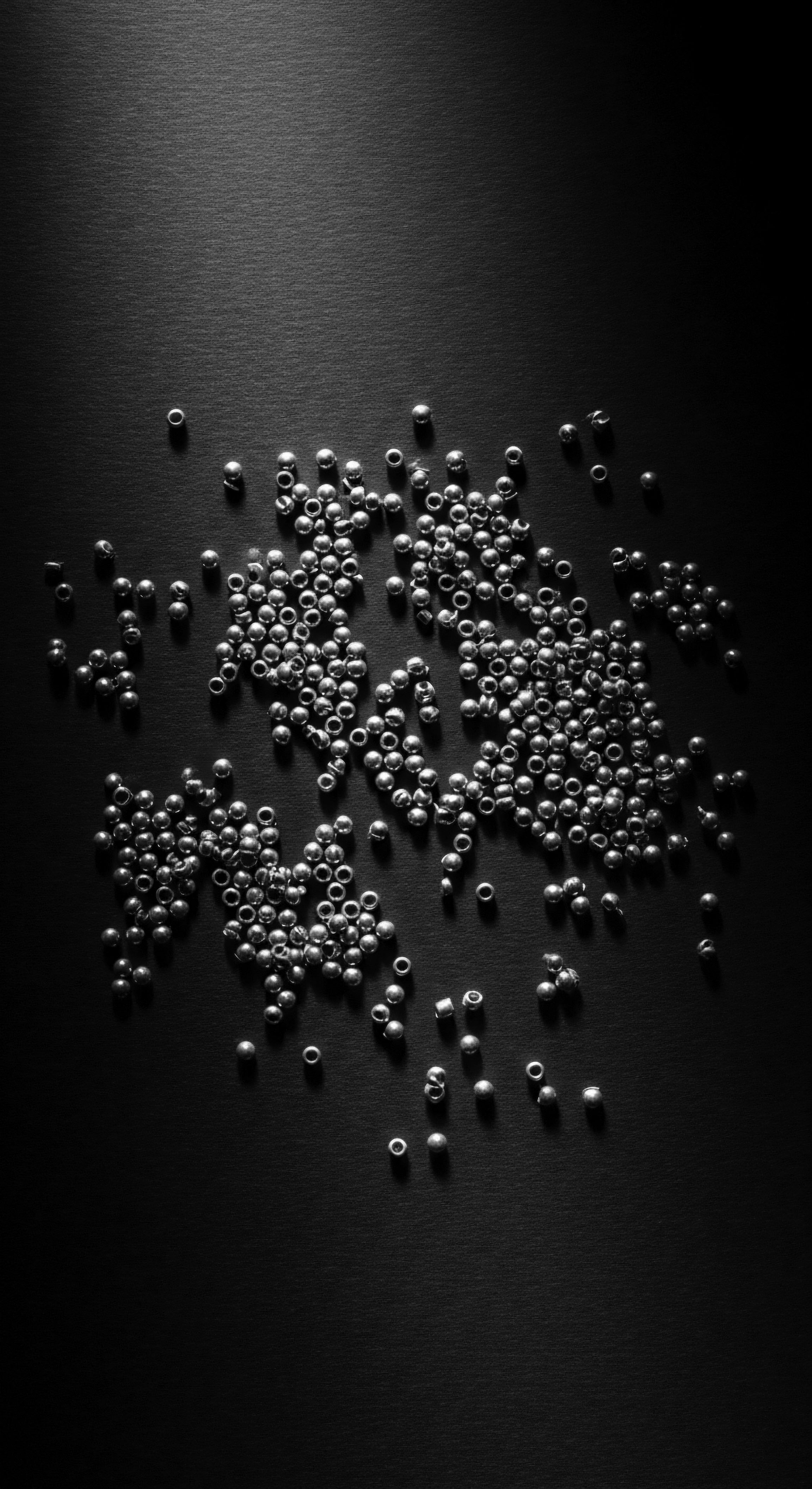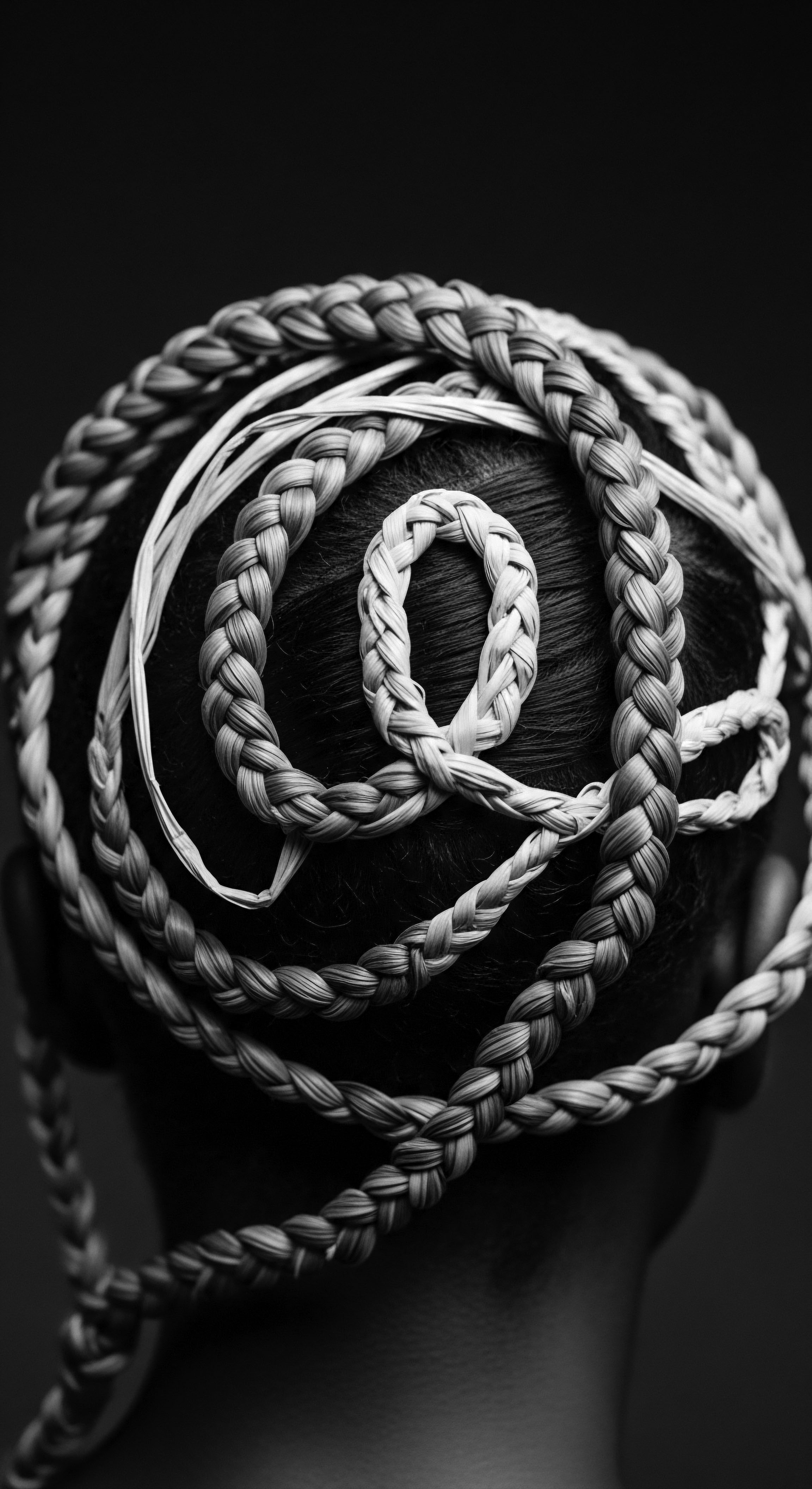
Roots
To journey into the heart of textured hair heritage means to recognize the echoes of ancient hands, ancient wisdom, and ancient reverence. For those whose strands coil and curve with singular grace, a deep ancestral memory resides within each curl, each kink, each wave. It is a memory stretching back millennia, connecting present-day communities to the sun-drenched lands of ancient Egypt.
This bond, far from a fleeting historical note, remains a living testament to continuity, a testament carved in the very structure of our hair, nurtured by customs passed through time. The story of our hair, its biology and its deep cultural significance, finds compelling origins along the Nile’s banks.

Anatomy and Ancestral Forms
The unique architecture of textured hair, often characterized by its elliptical follicle shape and varied curl patterns, determines its distinctive qualities ❉ its volume, its thirst for moisture, its ability to hold intricate styles. Modern trichology offers scientific language to describe these forms, yet ancestral communities understood these characteristics intuitively, developing care practices that respected hair’s inherent nature. This understanding wasn’t merely practical; it was often spiritual. Ancient Egyptians, too, understood the varied appearances of hair.
Their artistic renderings display a spectrum of hair presentations, from tightly plaited wigs to full, rounded coiffures, suggesting an appreciation for diverse hair forms. The way they adorned these styles, whether natural or constructed, speaks volumes about a refined relationship with physical appearance and its connection to deeper meaning.
The journey into textured hair heritage reveals ancient wisdom connecting present-day communities to ancient Egyptian reverence for hair.

Hair’s Ancient Expressions
Hair in ancient Egypt, whether natural or in the form of meticulously crafted wigs, served as a powerful visual communicator of one’s place in society, one’s age, and even one’s spiritual connection. For millennia, hairstyles in this civilization were not simply aesthetic choices. They were deliberate statements. Elite individuals, both men and women, frequently wore elaborate wigs, sometimes made from human hair, wool, or plant fibers, often intricately braided and adorned with precious materials.
These served as clear markers of wealth, social standing, and divine association. Even the famous ‘sidelock of youth’ worn by children, a single plait on one side of a shaven head, bore symbolic weight, representing youth and innocence.
The materials used for hair care in ancient Egypt reveal a profound connection to their environment and an early grasp of natural science. They employed various plant-based oils and fats. Castor oil, for example, was a staple, valued for its moisturizing and strengthening properties.
Henna, derived from the leaves of the Lawsonia plant, was used not only as a dye but also for its conditioning abilities, helping to cover gray hair and impart a reddish hue. These botanical wisdoms resonate with contemporary natural hair care, which often returns to the earth’s bounty for nourishment.

What Did Ancient Egyptian Hair Tools Look Like?
The archaeological record provides tangible evidence of the sophistication of ancient Egyptian hair care. Combs, some dating as early as 3900 BCE, were fashioned from materials like ivory, bone, and wood. These were not merely functional items; many were decorated with intricate animal motifs, suggesting a symbolic or ritualistic aspect to their use.
Such tools speak to the careful tending of hair, whether natural or wigged, and the value placed on hair presentation. The existence of specialized tools, even early razors made from stone, copper, then bronze, suggests a society that meticulously managed hair, even removing it to maintain hygiene or to wear wigs comfortably.
The understanding of hair structure, even without modern microscopes, led to practices that protected and enhanced hair. The use of oils, sometimes applied as hot oil treatments, indicates an intuitive grasp of how to seal moisture and soften strands, practices still highly valued in textured hair routines today. The application of fat-based products to hold styles, confirmed by analysis of mummy hair, speaks to an early form of styling gels, proving that styling products are far from a recent invention. This suggests a continuity of desire ❉ to shape, define, and preserve hair’s appearance.
| Ancient Egyptian Practice Castor Oil and Almond Oil use for hydration and strength. |
| Contemporary Textured Hair Connection Foundation of many modern hair oils and hot oil treatments. |
| Ancient Egyptian Practice Use of Henna for coloring and conditioning. |
| Contemporary Textured Hair Connection Natural dye and protein treatment, still popular for hair health. |
| Ancient Egyptian Practice Elaborate Wigs and hair extensions for aesthetic and protective purposes. |
| Contemporary Textured Hair Connection Wigs and extensions as protective styles and versatile fashion choices. |
| Ancient Egyptian Practice Use of fat-based styling products (gel) to hold styles. |
| Contemporary Textured Hair Connection Modern gels and custards for curl definition and hold. |
| Ancient Egyptian Practice The enduring wisdom of ancient Egyptian hair care continues to influence modern routines for textured hair. |

Ritual
The care of hair, particularly textured hair, has always extended beyond simple hygiene. It is a ritual, a profound connection to self, community, and ancestral pathways. In ancient Egypt, the intentional practices surrounding hair were deeply embedded in daily life and ceremonial moments, reflecting a heritage of purposeful care. This ritualistic approach, centered on protection and presentation, resonates powerfully within textured hair communities today, where styling is often a communal act, a moment of self-affirmation, or a cultural celebration.

Styling Techniques and Ancestral Roots
Ancient Egyptians employed a variety of techniques that find echoes in the protective styling traditions common among Black and mixed-race communities. Braiding, for instance, was a prevalent method, seen in both natural hair and in the construction of elaborate wigs. Wigmakers skillfully plaited human hair into numerous small braids to create these headpieces, sometimes layering curled hair over them. This reflects an understanding of how to manipulate hair for aesthetic appeal and preservation, a practice central to protective styling.
Hair care in ancient Egypt went beyond hygiene, serving as a ritual connecting individuals to their heritage and community.

Did Ancient Egyptians Wear Braids and Locs?
Yes, archaeological evidence and depictions confirm the widespread use of braids. Young girls wore their hair in plaits, and adult women often fashioned their hair into multiple narrow plaited or twisted tresses. The connection between ancient Egyptian styles and contemporary African hairstyles, such as dreadlocks and Nubian knots (also known as Bantu knots), is a topic explored by scholars.
These styles, characterized by coiling, braiding, and interlocking strands, have a long history across Africa, including ancient Egypt. Dreadlocks, specifically, are noted for their deep links to Kemetic Egyptian culture, where priests and spiritual leaders wore similar locked styles, symbolizing a connection to the past and a celebration of natural hair.
The very act of styling was often a communal endeavor, particularly for women, as depicted in tomb paintings. Hairdressers, or even servants, engaged in the careful washing, oiling, and combing of hair. This collaborative aspect of hair care speaks to its social function, not just as a personal grooming act, but as a shared experience, strengthening community bonds—a sentiment familiar to many in textured hair spaces where styling sessions become moments for conversation, connection, and the passing down of techniques.

The Tools of Transformation
The implements used in ancient Egypt for hair care were quite sophisticated for their time. Beyond combs made of ivory and bone, there is evidence of tools that may have functioned as tweezers or even tongs for curling hair. This suggests a desire to shape hair beyond its natural state, to create specific forms and textures, a goal shared by modern styling. The meticulous care of wigs, using emollients and oils from vegetable or animal fats, indicates a thorough regimen designed to maintain their appearance and integrity.
- Combs ❉ Crafted from bone, ivory, or wood, some adorned with animal motifs, reflecting both utility and artistic expression.
- Oils and Fats ❉ Used not only for conditioning but also as styling products, helping to hold intricate coiffures in place.
- Hair Extensions ❉ Early examples dating back to around 3400 BCE, indicating a long-standing practice of augmenting natural hair for desired length or volume.
The presence of hair extensions in ancient Egyptian burials, some dating to 3400 BC, reveals a continuous tradition of enhancing one’s natural hair. These additions, whether individual braids attached to natural hair or complete wigs, allowed for diverse and elaborate styles, serving both aesthetic and practical purposes. Wigs, for instance, offered protection from the harsh sun and acted as a barrier against lice, while still permitting body heat to escape due to their mesh foundations. This duality of beauty and utility speaks to a pragmatic yet visually conscious approach to hair.
The ritual of hair cleansing also holds ancient roots. Egyptians regularly washed their hair using mixtures of water and alkali salts, followed by the application of oils and conditioners. This foundational practice of cleansing and moisturizing forms the very basis of healthy hair regimens across diverse cultures today, highlighting a wisdom that transcends time. The continuity of these basic principles across millennia underscores a deep, ancestral understanding of hair’s needs.

Relay
The echoes of ancient Egyptian hair traditions resonate with distinct clarity in the textured hair communities of today. This is a profound relay of knowledge, a continuum of practices shaped by shared hair characteristics and a persistent drive for self-expression and cultural affirmation. Understanding this connection moves beyond surface-level similarities; it requires an examination of deep cultural meanings, scientific validations, and the enduring power of ancestral memory.

Ancestral Practices Validated by Modern Science
One remarkable link lies in the early understanding of hair’s need for specific care in dry climates. Ancient Egyptians meticulously applied natural oils, such as castor oil, almond oil, and moringa oil, to combat the desert’s harsh effects, providing hydration and strengthening hair. Modern scientific inquiry often confirms the efficacy of these traditional components.
For instance, castor oil, a staple in Egyptian hair care, is now recognized for its richness in fatty acids, which contribute to hair growth and thickness. This convergence of ancient wisdom and contemporary understanding speaks to a deep, experiential knowledge passed down through generations.
Ancient Egyptian hair traditions echo in textured hair communities today, showcasing a relay of knowledge and purposeful care.

How Does Hair Oiling Connect Generations?
The practice of hair oiling, widely used in ancient Egypt, remains a cornerstone of textured hair care. This ritual, involving the massage of oils into the scalp and along the hair shaft, promotes scalp health and strengthens strands. The tactile, nurturing aspect of this practice, often performed within families or among close relations, fosters intergenerational bonds. It is a quiet language of care, a physical manifestation of heritage transmitted from grandmother to mother to child.
This is a living archive, where each application of oil becomes a moment of connection to a vast lineage of care providers. The act itself becomes a meditation on historical continuity.
Beyond mere aesthetics, ancient hair practices, particularly those involving wigs and extensions, also served practical purposes that resonate with today’s protective styles. In ancient Egypt, wigs shielded the scalp from sun exposure and helped maintain hygiene by deterring lice. Similarly, modern protective styles, like braids, twists, and locs, safeguard textured hair from environmental damage, mechanical stress, and promote length retention. The continuous use of wigs and extensions by elite Egyptians for thousands of years, as documented by Egyptologist Dr.
Joann Fletcher, highlights their importance for both vanity and cleanliness. This indicates an ancestral understanding of hair protection, predating modern scientific explanation.
The deliberate choice to shave or crop natural hair in ancient Egypt and adorn elaborate wigs also signifies a sophisticated approach to hair management. This practice, often linked to ritual purity for priests, also speaks to a desire for consistent, styled appearance despite environmental challenges. This aligns with the contemporary choice within textured hair communities to use wigs as a protective layer, allowing natural hair to rest and thrive beneath, while offering diverse styling versatility. The underlying principle—preserving hair health while maintaining a desired aesthetic—remains remarkably consistent across these historical and cultural divides.
Consider the significance of combs. From elaborately decorated ivory combs dating to 3900 BCE, used for detangling and perhaps ritual adornment, to the modern wide-tooth combs favored by textured hair communities, the core function remains constant ❉ to manage and arrange strands. This continuity of tools underscores the enduring characteristics of textured hair that require gentle, thoughtful detangling and styling methods across millennia.
- Oiling Hair ❉ The use of castor, almond, and moringa oils for scalp and strand nourishment, a practice continued in many textured hair regimens today.
- Wig and Extension Use ❉ Employment of constructed hair for protection, hygiene, and social standing, mirroring modern protective styling choices.
- Braiding Techniques ❉ Extensive use of plaits for natural hair and wig creation, reflecting foundational styling methods in Black hair traditions.
- Hair Gels/Fats ❉ Application of fat-based products to hold styles, a precursor to modern styling gels for curl definition.
The historical record shows that hair was far more than an aesthetic feature in ancient Egypt. It conveyed identity, social standing, and even held spiritual power. This cultural weight echoes in the experiences of Black and mixed-race communities, where hair remains a powerful symbol of identity, resistance, and heritage.
During periods of oppression, such as the transatlantic slave trade, hair became a tool for survival and communication, with cornrows even used to create maps for escape. This powerful connection between hair, freedom, and identity remains a central tenet of textured hair heritage.

Reflection
In contemplating the profound journey of textured hair, from the sun-kissed sands of ancient Egypt to the vibrant, diverse communities of today, we witness a heritage not merely preserved in relics and texts, but alive within each strand. It is a legacy of intentional care, of artistry, and of deep spiritual connection that transcends the boundaries of time and geography. The ancient Egyptian reverence for hair, expressed through their oils, their intricate styles, and their ceremonial wigs, pulses through the very veins of modern textured hair practices. This enduring resonance is not accidental; it speaks to the intrinsic qualities of hair itself and the ancestral wisdom that recognized its unique needs and profound capacity for expression.
Our hair carries stories, whispers of generations past, inviting us to listen, to learn, and to honor the continuum of its sacred presence. This connection serves as a powerful reminder that our self-care rituals are not isolated acts, but rather a continuation of an ancient, unbroken chain of wisdom and affection for the crown we wear.

References
- Fletcher, Joann. 1995. Ancient Egyptian Hair and Wigs. Ph.D. Dissertation, University of Manchester.
- Fletcher, Joann. 1998. The Human Hair ❉ Its Structure, Function, and Cultural Significance Through the Ages. In Ancient Textiles, Production, Craft, and Art. pp. 119-126.
- Lucas, Alfred. 1930. Ancient Egyptian Materials and Industries. Edward Arnold & Company.
- McCreesh, Natalie. 2011. An Ancient Egyptian Wig ❉ Construction and Reconstruction. Internet Archaeology, 42.
- Robins, Gay. 2020. Hair, Gender, and Social Status in Ancient Egypt. JSTOR Daily.
- Kamal, Hassan. 1991. The Ancient Egyptian Medicine. Madbouli Library.
- Redford, Donald B. 2001. The Oxford Encyclopedia of Ancient Egypt, Vol. II. Oxford University Press.
- Herodotus. The Histories. Translated by Aubrey de Sélincourt. Penguin Books, 1954.
